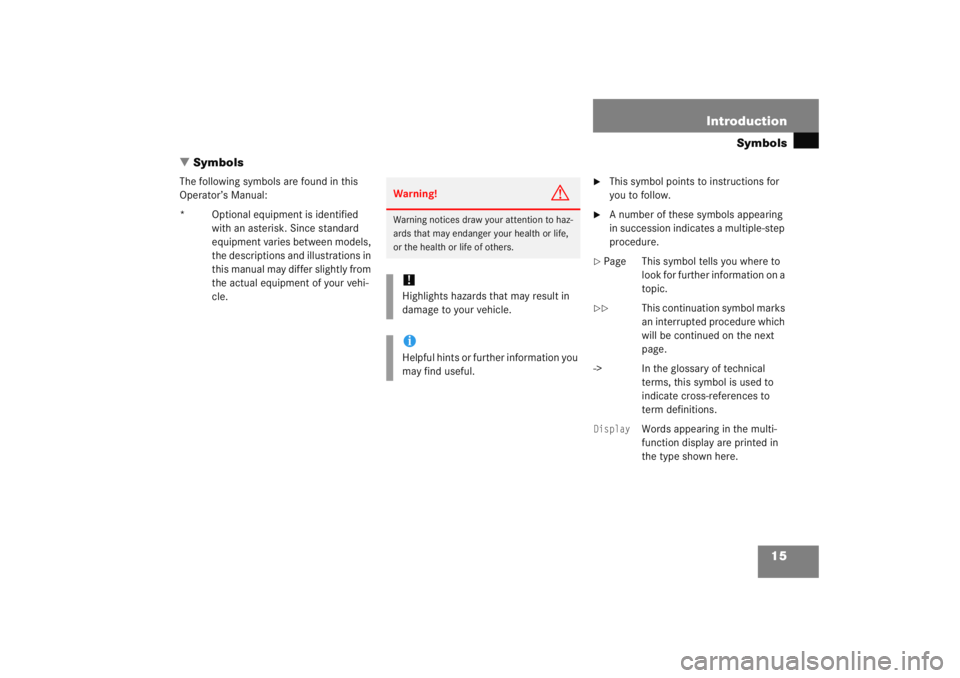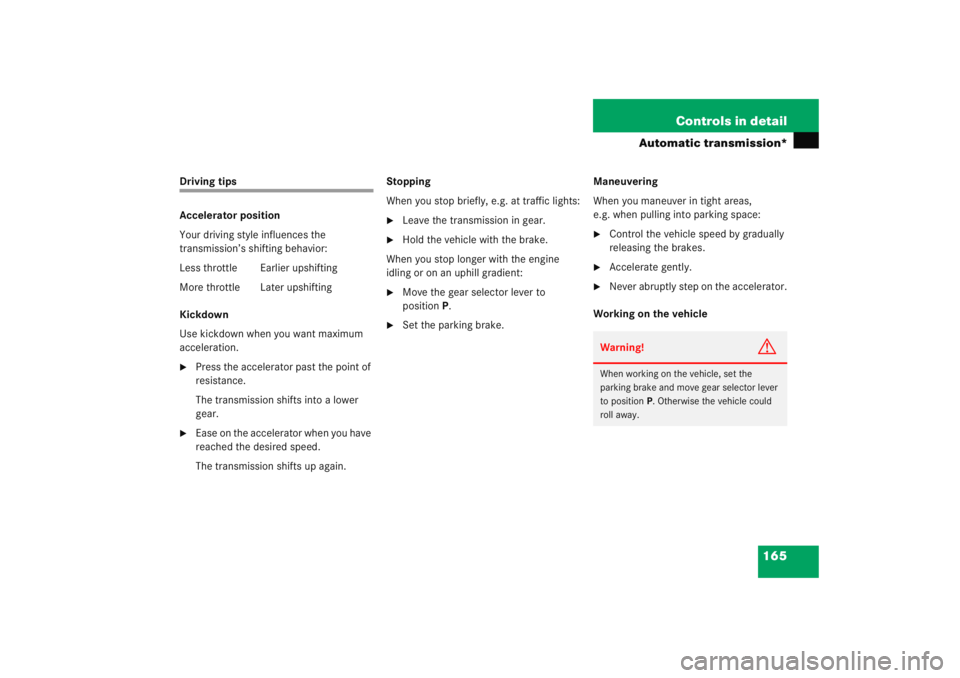Page 16 of 474

15
Introduction
Symbols
� Symbols
The following symbols are found in this
Operator’s Manual:
* Optional equipment is identified
with an asterisk. Since standard
equipment varies between models,
the descriptions and illustrations in
this manual may differ slightly from
the actual equipment of your vehi-
cle.
�
This symbol points to instructions for
you to follow.
�
A number of these symbols appearing
in succession indicates a multiple-step
procedure.
� Page This symbol tells you where to look for further information on a
topic.��
This continuation symbol marks
an interrupted procedure which
will be continued on the next
page.
-> In the glossary of technical terms, this symbol is used to
indicate cross-references to
term definitions.
Display
Words appearing in the multi-
function display are printed in
the type shown here.
Warning!
G
Warning notices draw your attention to haz-
ards that may endanger your health or life,
or the health or life of others.!Highlights hazards that may result in
damage to your vehicle.iHelpful hints or further information you
may find useful.
Page 112 of 474

111
Controls in detail
Lighting
Manual headlamp mode
The low beam headlamps and parking
lamps can be switched on and off with the
exterior lamp switch.
Automatic headlamp mode
The following lamps switch on and off
automatically depending on the brightness
of the ambient light:
�
Low beam headlamps
�
Tail and parking lamps
�
License plate lamps
�
Side marker lamps
�
Turn exterior lamp switch to
position
U.
With the SmartKey in starter switch
position 1, only the parking lamps will
switch on and off automatically.
When the engine is running, the low
beam headlamps, the tail and parking
lamps, the license plate lamps and the
side marker lamps will switch on and
off automatically.
iWith the SmartKey removed from the
starter switch and the driver’s door
open, while the parking lamps or low
beam headlamps are switched on, �
a warning sounds
�
$ appears in the multifunction
display
�
the message
Switch off lights.
appears in the multifunction display
Warning!
G
If the exterior lamp switch is set to U,�
the headlamps may switch off unexpect-
edly when the system senses bright am-
bient light, for example light from
oncoming traffic.
�
the headlamps will not be automatically
switched on under foggy conditions.
To minimize risk to you and to others, acti-
vate headlamps by turning exterior lamp
switch to B when driving or when traffic
and / or ambient lighting conditions require
you to do so.
In low ambient lighting conditions, only
switch from position U to B with the
vehicle at a standstill. Switching from U
to B will briefly switch off the head-
lamps. Doing so while driving in low ambient
lighting conditions may result in an acci-
dent.
The automatic headlamp feature is only an
aid to the driver. The driver is responsible for
the operation of the vehicle's lights at all
times.
Page 166 of 474

165
Controls in detail
Automatic transmission*
Driving tips
Accelerator position
Your driving style influences the
transmission’s shifting behavior:
Less throttle Earlier upshifting
More throttle Later upshifting
Kickdown
Use kickdown when you want maximum
acceleration.�
Press the accelerator past the point of
resistance.
The transmission shifts into a lower
gear.
�
Ease on the accelerator when you have
reached the desired speed.
The transmission shifts up again.
Stopping
When you stop briefly, e.g. at traffic lights:
�
Leave the transmission in gear.
�
Hold the vehicle with the brake.
When you stop longer with the engine
idling or on an uphill gradient:
�
Move the gear selector lever to
position P.
�
Set the parking brake. Maneuvering
When you maneuver in tight areas,
e.g. when pulling into parking space:
�
Control the vehicle speed by gradually
releasing the brakes.
�
Accelerate gently.
�
Never abruptly step on the accelerator.
Working on the vehicleWarning!
G
When working on the vehicle, set the
parking brake and move gear selector lever
to position P. Otherwise the vehicle could
roll away.
Page 387 of 474

386 Practical hintsReplacing bulbs
Notes on bulb replacement�
Use only 12-volt bulbs of the same type
and with the specified watt rating.
�
Switch lights off before replacing a bulb
to prevent short circuits.
�
Always use a clean lint-free cloth when
handling bulbs.
�
Your hands should be dry and free of oil
and grease.
�
If the newly installed bulb does not
come on, visit an authorized
Mercedes-Benz Center.
Have the LEDs and bulbs for the following
lamps replaced by an authorized
Mercedes-Benz Center.
�
Additional turn signals in the exterior
rear view mirrors
�
High mounted brake lamp
�
Xenon* lamps
�
Front fog lamps
Replacing bulbs for front lamps
Before you start to replace a bulb for a
front lamp, do the following first:�
Turn the exterior lamp switch to
position M (
�page 110).
�
Open the hood (
�page 291) (except
for side marker lamps).
Halogen headlamps
Left headlamp, mirror-image of right
headlamp1 Housing cover for low beam headlamp
2 Housing cover for high beam head-
lamp, parking and standing lamp
Warning!
G
Bulbs and bulb sockets can be very hot. Al-
low the lamp to cool down before changing
a bulb.
Keep bulbs out of reach of children.
Halogen lamps contain pressurized gas.
A bulb can explode if you�
touch or move it when hot
�
drop the bulb
�
scratch the bulb
Wear eye and hand protection.
Because of high voltage in Xenon lamps, it is
dangerous to replace the bulb or repair the
lamp and its components. We recommend
that you have such work done by a qualified
technician.
Page 406 of 474

405
Practical hints
Jump starting
The battery is located in the engine com-
partment on the right hand side. The
terminals for jump starting are located in
front of the battery.�
Make sure the two vehicles do not
touch.
�
Turn off the engine.
On both vehicles:
�
Turn off all electrical consumers.
�
Apply parking brake.
�
Shift gear selector lever to position P
(manual transmission to Neutral). 1
Positive terminal of charged battery
2 Positive under hood terminal in front of
discharged battery
3 Negative terminal of charged battery
4 Negative under hood terminal in front
of discharged battery
�
Connect positive terminal 1 of the
charged battery with positive under
hood terminal 2 in front of the dis-
charged battery with the jumper ca-
bles. Clamp cable to charged
battery 1 first.
�
Start engine of the vehicle with the
charged battery and run at idle speed.
�
Connect negative terminal 3 of the
charged battery with negative under
hood terminal 4 in front of the dis-
charged battery with the jumper
cables. Clamp cable to charged
battery 3 first.
�
Start the engine of the disabled
vehicle.
Now you can turn on the electrical con-
sumers. Do not turn on the lights under
any circumstances.
�
Remove the jumper cables first from
negative terminals 4 and 3 and then
from positive terminals 2 and 1.
You can now turn on the lights.
�
Have the battery checked at the
nearest authorized Mercedes-Benz
Center.
Warning!
G
Keep flames or sparks away from battery.
Do not smoke.
Observe all safety instructions and precau-
tions when handling automotive batteries
(�page 297).
!Vehicles with automatic transmission:
Do not tow-start the vehicle.